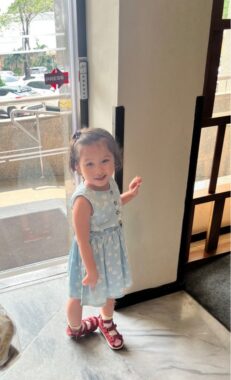Cutting our daughter’s hair: A journey of tangles and tears
For this columnist, keeping his daughter's hair trimmed is not an easy task
Written by |

As my daughter’s shaky hand brought the food to her mouth, sauce and pieces of food stuck to her long, curly hair.
Despite her fixating on the fork and sticking out her tongue for extra support, Rylae-Ann’s aromatic l-amino acid decarboxylase (AADC) deficiency symptoms were making eating arduous. Although more spaghetti was scattered on the floor with each bite, we clapped and cheered her on.
Independent eating had seemed impossible before Rylae-Ann received gene therapy treatment with Upstaza (eladocagene exuparvovec) when she was 18 months old. So, although it was messy, we were incredibly proud of her. Yet the mess posed an issue that had to be addressed.
As her hair had grown, it had become increasingly tangled and more difficult to manage. Typical parents might say, “Just go get a haircut!” But Rylae-Ann’s anxiety is a force that cannot be ignored, and a simple task for other families is a complicated and collaborative undertaking for my wife, Judy, and me.
This is how Rylae-Ann’s ongoing journey of getting a haircut began.
The first haircut
Rylae-Ann didn’t have a choice regarding her first haircut. She couldn’t have resisted even if she’d wanted to, due to her AADC deficiency symptoms. She’d been selected to participate in a clinical trial for gene therapy, which was administered through cannulas that entered her brain from the front of her scalp. To perform this procedure, doctors needed that area free of hair.
We decided to have her entire head shaved, not just the incision site. Where we live in Asia, head shaving has a symbolic meaning. It symbolizes purification, and for us, it was also a way to celebrate the beginning of her rebirth. Rylae-Ann cried but couldn’t move, so the process was rather straightforward.

Rylae-Ann has her head shaved during her first haircut to prepare for gene therapy. (Photo by Richard E. Poulin III)
Quick and painless
While her hair grew longer after gene therapy, her skills improved. She learned to move, walk, and much more. Worrying about having a fashionable kids’ haircut was far from my mind. But as she became more active, her hair became more tangled.
We did our best to comb and wash it, but her naturally wavy hair was a perfect net for anything and everything. We pushed for her to be independent, and mistakes like the above-mentioned eating session accompanied that goal.
During our first trip to a kids’ beauty salon, we didn’t realize that having her hair cut would be a fear-inducing event. Each trip after that resulted in screaming and tears, regardless of a variety of tricks we had deployed. We eventually gave up on trying to go to salons, but the tangled problem only worsened.
One day, after a long day at school, Rylae-Ann and Judy were at odds during a bath. Judy tried her best to comb out remnants of an exciting art activity that had led to exceptionally stuck tangles. Judy worked in hair conditioner, but Rylae-Ann was not in the mood to be compliant. Out of frustration, Judy grabbed a pair of scissors and chopped off Rylae-Ann’s hair in one movement before Rylae-Ann could react.
After several minutes of calming Rylae-Ann down, I got a look at her new hairdo. It didn’t look bad. It was very short, so she wouldn’t need another haircut for a while.
The next time, Judy and I agreed we would apply a more responsible approach. Drama therapy — using theater techniques, improvisation, and role-playing — had worked wonders before, improving Rylae-Ann’s experience with hospital visits, so we decided to try that. We had a year to prepare.

Rylae-Ann shows off a new hairstyle a few weeks after her mom cut it during a bath. (Photo by Richard E. Poulin III)
Drama therapy strategy
The third time was supposed to be the charm. Armed with a hefty dose of patience, Judy and I started with role-playing. We used one of Rylae-Ann’s favorite stuffed animals to pretend play that we were visiting the hairdresser. We all pampered the teddy bear and used a set of toy beauty products. The bear even got a chance to pretend to cut my hair.
We then transitioned to Rylae-Ann’s turn to get her hair pretend-cut. We started with toy beauty products and then sneakily used real scissors. We got two cuts in before she quickly caught on.
Obviously, crying ensured, and now she walks around with half-cut, half-tangled hair. No one notices, though, and it will eventually grow out. But soon enough, her hair will get to a point where it must be cut again.
I don’t know how we’ll accomplish that, but it will have to happen this year — hopefully, minus the tears.
Note: AADC News is strictly a news and information website about the disease. It does not provide medical advice, diagnosis, or treatment. This content is not intended to be a substitute for professional medical advice, diagnosis, or treatment. Always seek the advice of your physician or other qualified health provider with any questions you may have regarding a medical condition. Never disregard professional medical advice or delay in seeking it because of something you have read on this website. The opinions expressed in this column are not those of AADC News or its parent company, Bionews, and are intended to spark discussion about issues pertaining to aromatic l-amino acid decarboxylase deficiency.






Leave a comment
Fill in the required fields to post. Your email address will not be published.